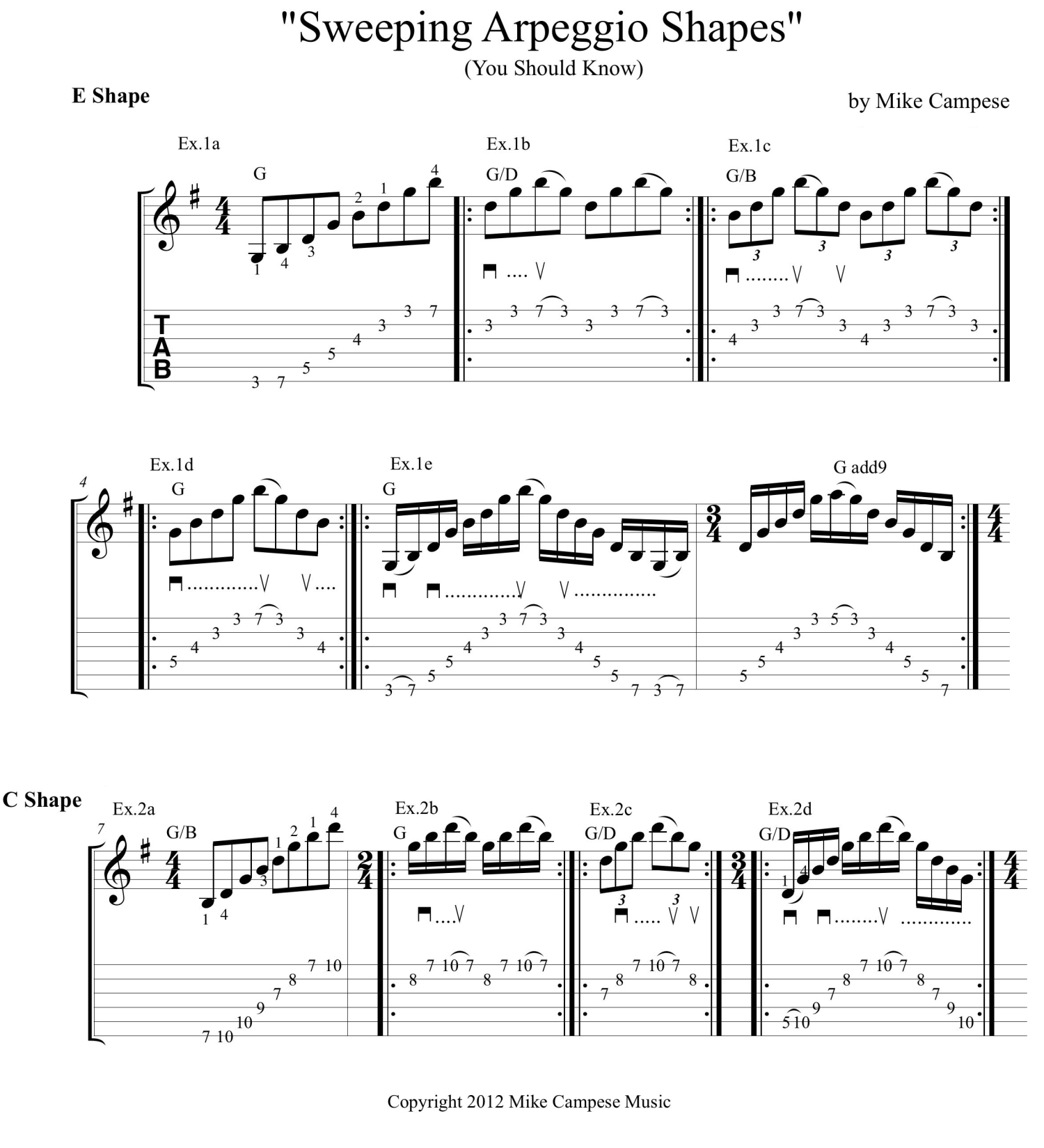Happy New Year! In this lesson I will be showing you some sweeping arpeggio shapes you should know. I covered sweeping in a previous lesson but I want to get a little more detailed this time and show you some common shapes.
For this lesson we will be covering major arpeggios. If you are not sure what a arpeggio is, it is a broken chord, a major arpeggio is built off the first, third and fifth of a major scale. The shapes in this lesson are based from arpeggio or chord inversions. A chord inversion describes the relationship of its bass to the other tones of the chord.
For example, a G major triad is G, B, and D, in the first inversion the B is in the bass and in the second inversion the D is in the bass. All the example are in G. But, be sure to move them around in all keys.
Examples 1a-1e are based on the E shape, meaning the E chord shape. This is the same concept as constructing bar chords based on basic chords.
Example 1a is a G major arpeggio 6th string 2 octave pattern that is a moveable shape; the first finger is the root. When you are first working on sweep picking you should start with just 2 strings, like in Example 1b, and then build from there. I added a pull-off to these shapes. But, you can do it without it.
MP3 - Sweeping Arpeggio Shapes, Example 1a
MP3 - Sweeping Arpeggio Shapes, Example 1b
Example 1c is a 3 string arpeggio with legato, also in G, and then Example 1d adds the 4 string. I included the right hand picking pattern. Be sure to start real slow and don't let the notes ring together like a chord. All these shapes are moveable, if you know where the root is in each pattern, it would make it easier to move them around.
MP3 - Sweeping Arpeggio Shapes, Example 1c
MP3 - Sweeping Arpeggio Shapes, Example 1d
With Example 1e we are using all 6 strings with the E shape with the G major arpeggio. In bar 2 I added the ninth, which would be a A note on the first string.
MP3 - Sweeping Arpeggio Shapes, Example 1e
Now we will move on to the C shape with Example 2a, which is based on a C chord and is off the G arpeggio again. The root is on the 5th string. I gave you the full range of notes in one position. This arpeggio is most commonly played with just 5 strings, it is easier to sweep with just the 5 strings.
MP3 - Sweeping Arpeggio Shapes, Example 2a
Example 2b is the same idea as Example 1b, with just 2 strings and using pull-offs. This would be considered a root position arpeggio. Next we will add the 3rd string in Example 2c. This is considered a 2nd inversion arpeggio, the D is in the bass. Be sure to get the notes really smooth and clean when sweep picking this.
MP3 - Sweeping Arpeggio Shapes, Example 2b
MP3 - Sweeping Arpeggio Shapes, Example 2c
Example 2d is a sweeping arpeggio using 5 strings. Instead of playing the D note on the 6th string, I moved it to the 5th string. This makes it much easier to sweep this; just hammer the first note. This one sounds really cool fast, be sure to follow the sweeping symbols.
MP3 - Sweeping Arpeggio Shapes, Example 2d

OK, that is it for now! In the next lesson we will cover some more shapes. Visit mikecampese.com for more information.
Mike Campese is an all-around music performer, session artist and teacher competent in many musical styles, electric and acoustic. He has studied at G.I.T. (Honors Graduate), and with Paul Gilbert, Norman Brown, Stanley Jordan, Scott Henderson and Keith Wyatt.